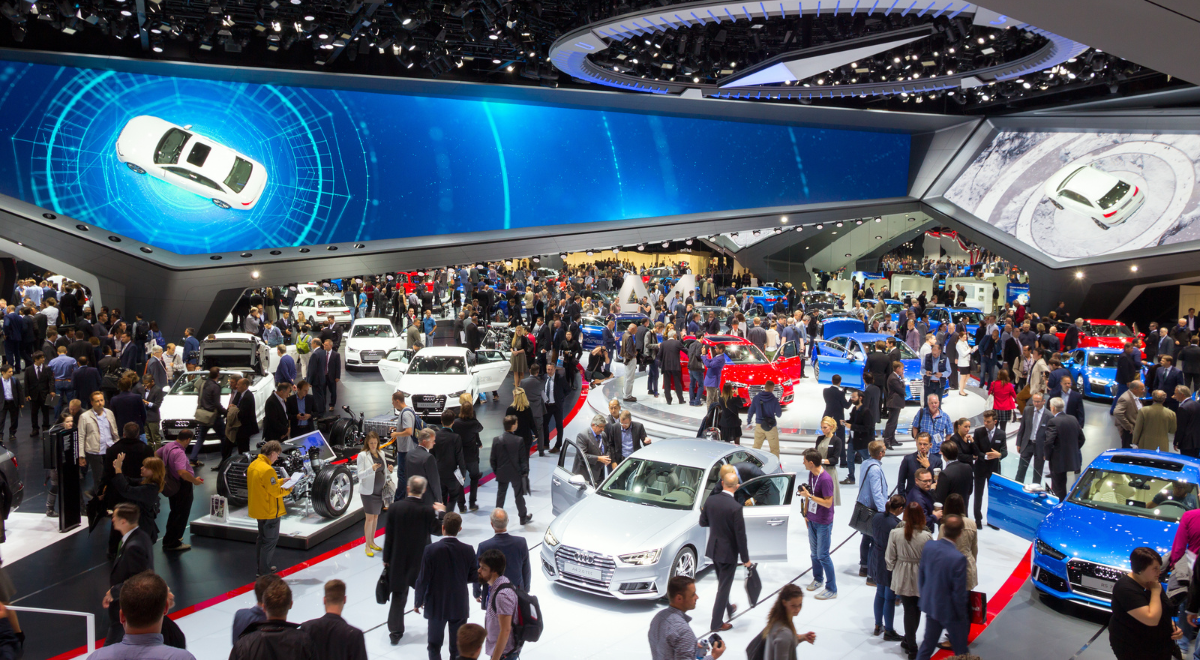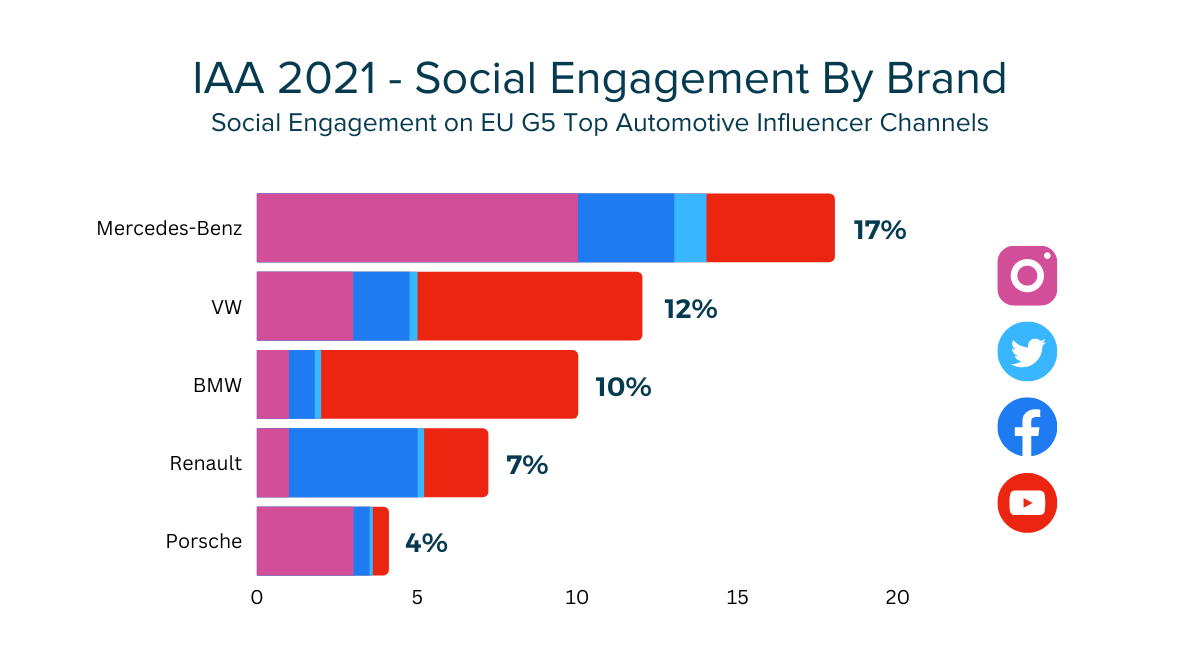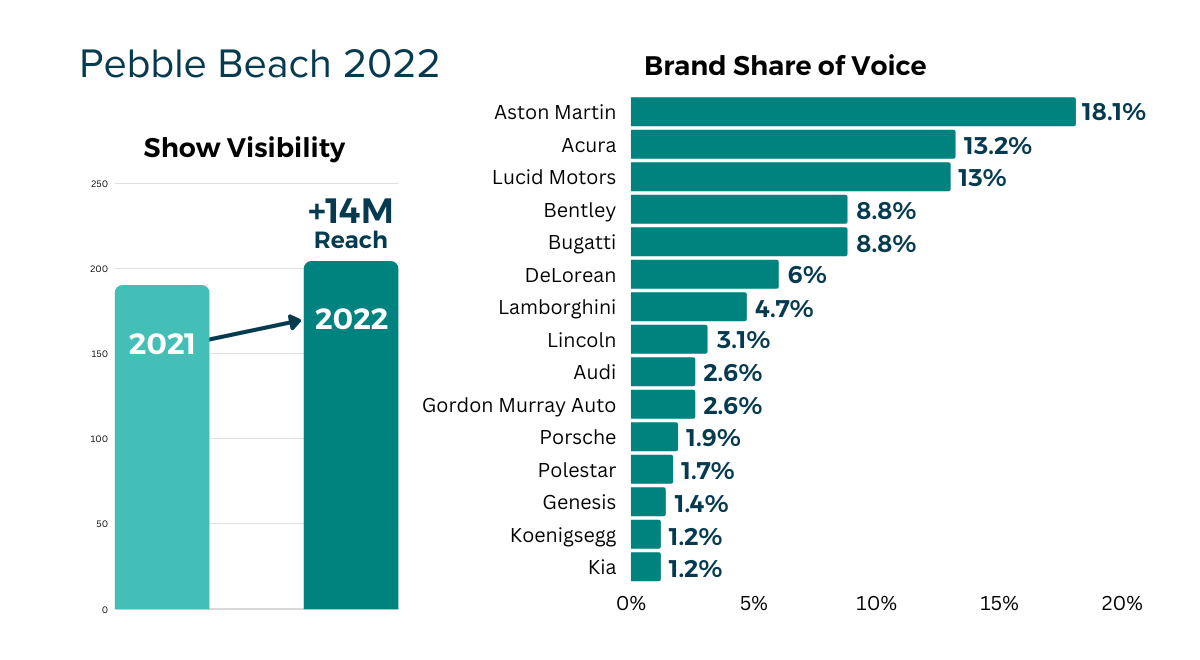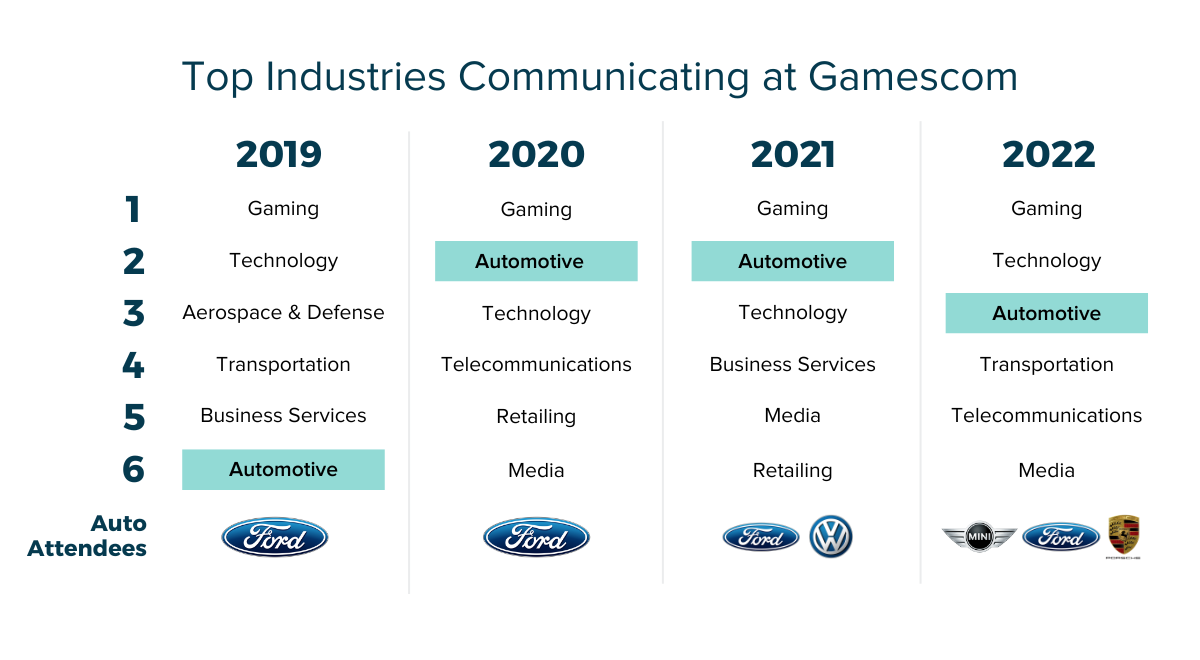
The motor show was long seen as the primary destination for carmakers looking to lay down a marker and exhibit their latest models and cutting-edge concept vehicles.
For years, manufacturers flocked to destinations like Detroit, Geneva, Paris, Shanghai, Frankfurt and Tokyo and spent significant marketing budgets to showcase their brands. But as we’ve moved into a digital world, have they become less essential than they once were? In the increasingly fragmented media landscape of 2022, there are now more ways to launch a product and reach an audience than ever before.
A new car purchase journey can start and finish online without a test drive or an in-person discussion at a dealership. Consumers now have TikTok videos, YouTube reviews and virtual showrooms to guide their decisions. Tesla’s Elon Musk-led standalone events have also kick-started a trend of manufacturers revealing new models on their own terms, without having to share the spotlight with competitors.
These natural shifts from the physical to virtual have been accelerated by the pandemic. If unveiling a car to consumers and journalists in digital gatherings can reach a large audience, what role does the motor show play in the overall communications mix?
The Global Motor Show Post-Covid
Of the major shows to return post-pandemic, many have reconfigured themselves to respond to new trends and attract visitors. In Europe, the IAA Mobility show returned in 2021, leaving its home in Frankfurt and heading to Munich. Under the tagline “mobility for all”, exhibitors took over the city centre where visitors could test out bicycles, e-scooters and enjoy arts and culture events.
A 12km ‘Blue Lane’ linked this area to the Munich exhibition centre, where manufacturers presented concepts around the future of mobility. The IAA Virtual platform also allowed trade and public delegates to follow events from afar, live and on-demand. Mercedes-Benz, on home turf for IAA, saw strong social media engagement thanks to its EQS and EQE models. The brand registered three of the top 10 brand hashtags from the event, while the lightning bolt emoji (landing second in the emoji prevalence top 10) indicated the importance of e-mobility.

The biennial Paris Motor Show, at one point considered a major event in the motoring calendar, returned in October 2022 but the show floor was dominated by French home brands like Alpine, Peugeot and Renault, with many manufacturers choosing to skip it entirely. The Geneva International Motor Show, which hasn’t been held in the 2020s due to the pandemic, will return in late November 2023 but at a new home in Qatar.
The North American International Auto Show (NAIAS) in Detroit is another example of a show seeking to reboot itself in a new era. 2022’s Detroit moved from its traditional January date to September, using the warmer weather to take the event outdoors with drone shows and live entertainment.
The show was not without headlines. President Joe Biden, a self-confessed “car guy”, visited to champion the US’s electric vehicle (EV) push and government investment in battery plants. Ford, meanwhile, organised a ‘Mustang Stampede’, which saw more than 1,000 cars, and six generations of Mustang, travel to downtown Detroit. It culminated with the reveal of the seventh-generation Mustang, which arrived under camouflage before being unveiled to the world’s press.
The Motor Show’s Place in the Comms Mix
The Mustang’s reveal is just one example of the media attention that can be generated when the car industry converges into one place. Shows like Detroit still provide a tried-and-tested infrastructure for reporters, influencers, marketers and manufacturers to gather. They’re also increasingly becoming venues for off-site events, where comms teams can gather journalists and focus their messaging outside the hectic schedules on the convention floor.
The Mustang’s reveal is just one example of the media attention that can be generated when the car industry converges into one place. Shows like Detroit still provide a tried-and-tested infrastructure for journalists, influencers, marketers and manufacturers to gather.
Laura West, Cision’s automotive Insights Director in the US, notes that off-sites connected to motor shows are ideal for “leveraging the buzz” around the event. “You can do something of your own that’s for your brand with journalists just focused on you. The off-site can almost be bigger than doing something internally at the show,” she said.
Cision’s Senior Research Analyst in the US, Ben Davie, who has more than a decade of motoring experience, adds: “Manufactures pay millions just for the show space, and then they have to buy the stages and pay the personnel to stand with the cars. [With an off-site] they can spend relatively the same amount, if not less, and target and expand their message.”
For car manufacturers still looking to capitalise on live events, specialist auto shows are becoming a viable option. Monterey Car Week in California is synonymous with high-end luxury vehicles, leading to the Pebble Beach Concours d'Elegance.
One of the most prestigious car events in the world, Pebble Beach has evolved from a vintage car show into one of supercars and cutting-edge EV concepts. However, this summer’s event saw unexpected attendees like Kia make headlines with the electric EV6 GT.
“Pebble Beach has never been a huge deal, it was always for old cars. A couple of years ago, they started showing concepts – and this year was the biggest one yet. There were way more OEMs (original equipment manufacturer) than I've ever seen before,” says Davie.
West adds that, as coverage around automotive is shifting, venues like Pebble Beach are now “the place to be”. “The world is focused on EVs and luxury vehicles. The volume brands, they’re not that interesting to the media right now,” she says.
“Luxury brands are getting a lot out of events like Pebble Beach. And Kia showed up, which was a big thing in the media because they’re not seen as a premium brand. But they brought a cool EV.”
According to Cision data, overall media visibility for Pebble Beach in 2022 increased by more than 14 million compared to the previous year. Kia’s surprise inclusion in the show line-up saw it feature among the top 15 brands in share of voice, sitting alongside premium brands like Aston Martin and Acura.

Why Auto Brands are Turning to Tech
The move is indicative of a wider motoring trend post-pandemic. If events like Detroit and Paris aren’t where manufacturers want to go, where should they look? The answer may be in targeting specialist events where they can stand out from the crowd, such as tech shows like CES.
In Germany, this year’s gamescom saw concept cars from BMW-MINI and Porsche tying in with Pokemon and Gran Turismo, while Ford esports team Fordzilla brought a high-end gaming chair. Ford appears in video games more than any other car brand, and has a gaming department that creates virtual vehicles living in the metaverse. According to West, this is giving manufacturers an opportunity to build their brand outside of traditional motoring events.
“People get really excited about buying [virtual Ford cars],” she says. “These are digital-only possessions, but they also do something for the brand. It’s not really considered marketing straight to the consumer, but I’m interested to see if it could eventually loop back and drum up actual buyers and future consumers.”

Jonas Kolbe, Director of Strategic Operations for Cision Insights in Germany, notes that before car manufacturers attend a tech show they must first understand the story they’re trying to tell.
“What kind of journalists do they target and what type of outlet do they want to be positioned in?” he says. “If they want to be positioned as a more tech-oriented brand then they could consider a show like CES. That poses different challenges in terms of visibility as you may have to compete with Microsoft or Apple for attention. But it can lead to a completely different image for your brand if you do it right.”
How China is Reshaping the Autos Landscape
Though the larger motor shows across North America and Europe are struggling to regain momentum, in the APAC region biennial events in Shanghai and Beijing are showing increased global relevance, although the latter was recently postponed due to the country’s strict Covid laws.
However, China still leads the world in sales of EVs, and manufacturers like Build Your Dream (BYD), Great Wall Motor (GWM) and Nio are developing cutting-edge vehicles with Europe as a priority. They are also building EVs faster than their European and North American counterparts.
Bjoern Kunze, Senior Director, Analysis, for Cision Insights Germany, explains: “China is now building EVs much more efficiently, they have more access to resources and they don't have supply chain issues,” he says. “Chinese manufacturers are in the middle of overtaking the established car manufacturers in terms of EV production, so that might also influence their car shows.”
“China is now building EVs much more efficiently, they have more access to resources and they don't have supply chain issues. Chinese manufacturers are in the middle of overtaking the established car manufacturers in terms of EV production, so that might also influence their car shows.”
Chinese car brands’ presence in the West is only likely to grow in the coming years. BYD is in talks with several countries, including the UK, about setting up a factory making both batteries and vehicles. Nio, meanwhile, has launched in Germany, Denmark, Sweden and the Netherlands and will enter the UK in 2023.
Bing Cao, VP APAC Analysis for Cision Insights, is already seeing a trend of Chinese carmakers heading to Europe to promote their vehicles and concepts. “We’re seeing a lot more presenting their new cars and business strategies in Europe. This just happened at the Paris Motor Show, with GWM and BYD displaying their premium vehicles.”
As China’s share of the overall car market grows, the motor show is one such avenue where manufacturers can make their presence known and win headlines to gain credibility with Western car buyers.
Nio, Cao notes, recently sent CEO William Li to Europe as part of its global expansion. There Li delivered speeches and conducted interviews in English; something Western carmakers can’t always do if they want to launch in APAC.Though the larger motor shows across North America and Europe are struggling to regain momentum, in the APAC region biennial events in Shanghai and Beijing are showing increased global relevance, although the latter was recently postponed due to the country’s strict Covid laws.
The Future of the Motor Show
As organisers contend with significant upfront costs and confidence in post-Covid travel and event attendance returns, the motor show will continue to evolve and adapt to meet these demands. But what does the future hold for these industry flagship events?
Davie sees them getting smaller but more differentiated, with the pandemic resetting expectations and accelerating changes that were already happening. “A lot of people have changed their mindsets about large group events, and we may not ever go back to how life was before,” he says. “With that being said, I think we’ll see a lot more focus on offsite events for OEMs. They can control the narrative, invite a smaller group of people and have a larger impact.”
“I think we’ll see a lot more focus on offsite events for OEMs. They can control the narrative, invite a smaller group of people and have a larger impact.”
West views bigger motor shows catering to journalists with off-sites, before putting a focus on consumers during the show itself. Smaller events like Pebble Beach “will become about bringing your cool concept car to show, but they could become more expensive for manufacturers to participate in”.
For Cao, each motor show will need to shape a narrative and unique identity to evolve. “Some shows will position themselves as tech-centric. Some will position themselves as classic car shows as they develop in the future. They’ll hold online or offline events not only for the media, but also to attract public participation and show visits.”
Though motor show attendance figures may be declining post-Covid, they remain valuable as an industry tradition and a way to celebrate everything it has to offer. But to get journalists and visitors through the door they need to deliver a unique experience, and something much more immersive than a virtual event can. Detroit's Mustang Stampede and the IAA Mobility Show's takeover of Munich are two such attempts at creating buzzworthy events that capture the attention of the media and consumers.
Automotive comms teams will need to be smarter in how they plan and strategise around future events, too. If each has its own unique selling point, teams will need to carefully select shows that fit their desired target groups. And if going to a show isn’t the way forward, how viable is an owned event in reaching that audience? It’s key to match the right brand message, to the right event, at the right time.
To learn more about how Cision Insights can help PR and communications teams shape their strategies, get in touch and speak to one of our experts today.
Most Recent Posts
Cision Resources
-
E-books and Guides
Comprehensive how-to guides on strategy and tactics
-
Case Studies
What are other brands doing – and how can we learn from them?
About Simon Reynolds
Simon is the Content Marketing Manager at Cision UK. He worked as a journalist for more than a decade, writing on staff and freelance for Hearst, Dennis, Future and Autovia titles before joining Cision in 2022.
Learn More. Do More. demo new
PR Tips, Case Studies, and Product Updates

PR in the Age of Misinformation: Building and Maintaining Brand Trust
PR in the Age of Misinformation: Building and Maintaining Brand Trust looks at the rise of fake news, false information, and deepfakes – and the strategies (both proactive and reactive) that public relations and communications professionals can...

[On-Demand Webinar] The Next Generation of Media Intelligence: From Gorkana to CisionOne
Explore CisionOne, a revolutionary media intelligence platform, and the evolution of Gorkana. Learn key features and strategies from Luke Williams, CisionOne Product Marketing Manager. Elevate your media outreach to new heights!

How Ellisphere Boosted Campaign Engagement and Visibility
Find out how Ellisphere increased engagement on their campaign content by up to 48% using our Multichannel News Releases and Guaranteed Paid Placement.
